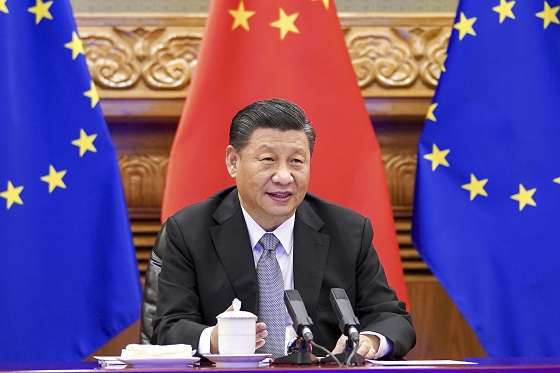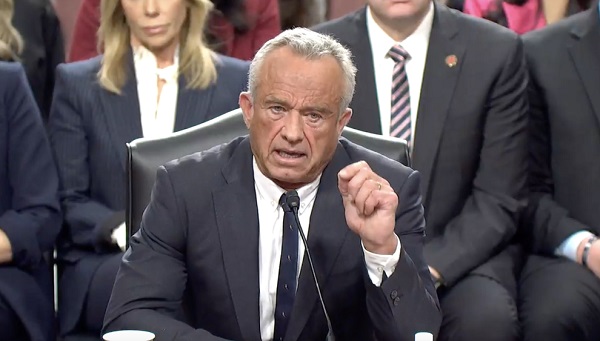Environment
Wall Street’s planned theft of America’s lands and waters

From the Frontier Centre for Public Policy
When we are issued carbon allowances, owners of said lands will be able to claim tax deductions and will be able to sell carbon allowances to businesses, families and townships. In the simplest of terms, that’s where the money will be made. WE peons will be renting air from the richest people on earth.
Everything will be monetized and measured and traded, even you.
Up next on Wall Street’s exploitation list.
If not stopped, on November 17th, the U.S. government will pass a rule that allows for America’s protected lands, including parks and wildlife refuges, to be listed on the N.Y. Stock Exchange. Natural Asset Companies (NACs) will be owned, managed, and traded by companies like BlackRock, Vanguard, and even China.
Since the early 2000’s, outfits like Goldman Sachs have been trying to trade air, or specifically carbon without much success. Their 2005 carbon exchange staggered along until it was quietly discontinued, and their Climate Exchange-Traded Fund (ETF) is now facing delisting. “ESG” was the next attempt to monetize the un-monetizable, with the “E” part of that acronym standing for Environment, ill-defined as that was. Now ESG is failing. Market leaders say it is facing “a perfect storm of negative sentiment” and its U.S. investments fell by $163 billion in the first quarter of 2023 alone.
Its stepchild, Net-Zero, is so loathed, it looks like it might blow up the entire carbon scam. Says Australian senator Matt Canavan, “Net-Zero has absolutely carked it. It is a soundbite and totally insane. Almost everything we grow, we make, we do in our society relies on the use of fossil fuels.” Vanguard has pulled out of Net-Zero funds. The British government too is backing out of Net-Zero, saying “we won’t save the planet by bankrupting the British people.” New Zealand’s new government revised the country’s Net-Zero plans in its first week in office. In the hard hit Netherlands, the Farmer-Citizen movement is now the dominant party in the Dutch senate and every provincial assembly. Sweden has abandoned its 100 percent Net-Zero plans and Norway has announced another $18 billion in oil and gas investments.
Not going to happen.
Even in the submissive E.U. voters are turning from the “green” parties toward anti-E.U. parties. Renewables funds are seeing massive outflows because of rising interest rates and declining subsidies. Of course, the massive subsidies taxpayers have already given both “renewables” investors and “renewables” companies will never be clawed back. All we will get is a shrug as they move onto the next kill. Which is so obvious it is a wonder no one predicted it.
The entire universe envies the lush interior of the U.S. Increasingly empty, it is filled with a cornucopia of minerals, fiber, food, waters, extraordinarily fertile soil as well as well-ordered, educated, mostly docile people. Worth in the quadrillions, if one could monetize and trade it, financialize it, the way the market has financialized the future labor of Americans, well, it would be like golden coins raining from the sky.
On October 4th, the Securities and Exchange Commission filed a proposed rule to create Natural Asset Companies (NACs). A twenty-one day comment period was allowed, which is half the minimum number of days generally required. NACs will allow BlackRock, Bill Gates, and possibly even China to hold the ecosystem rights to the land, water, air, and natural processes of the properties enrolled in NACs. Each NAC will hold “management authority” over the land. When we are issued carbon allowances, owners of said lands will be able to claim tax deductions and will be able to sell carbon allowances to businesses, families and townships. In the simplest of terms, that’s where the money will be made. WE peons will be renting air from the richest people on earth.
The following are eligible for NACs: National Parks, National Wildlife Refuges, Wilderness Areas, Areas of Critical Environmental Concern, Conservation Areas on Private and Federal Lands, Endangered Species Critical Habitat, and the Conservation Reserve Program. Lest you think that any conserved land is conserved in your name, the largest Conservation organization in the U.S., is called The Nature Conservancy, or TNC, which, while being a 501(c)3, also holds six billion dollars of land on its books. Those lands have been taken using your money via donations and government grants, and transferred to the Nature Conservancy, which can do with those lands what it wills.
If this rule passes, America’s conserved lands and parks will move onto the balance sheets of the richest people in the world. Management of those lands will be decided by them and their operations, to say the least, will be opaque.
μολὼν λαβέ, buddy.
Farm country is fighting back. American Stewards of Liberty, Committee for a Constructive Tomorrow, Kansas Natural Resource Coalition, Financial Fairness Alliance and Blue Ribbon Coalition have filed comments, Republican senators Pete Ricketts, James Risch and Mike Crapo have sent pointed queries to the SEC. This week, Rep. Harriet Hageman (R-WY) offered an amendment that would defund the SEC proposed rule to approve listing “NACs.”
Most of us ill-understand “financialization.” It is a complex set of maneuvers best explained by the behavior that crashed the economy in 2008 which bundled up questionable mortgages and brokered off the risk to dozens of different funds in order to share that risk. NACs are asset grabs. From ’09-’20, funds asset-stripped America’s manufacturing via debt obligations, buying the company, selling off the equipment, firing the most expensive employees, and gutting, if they could, pension funds. Then they upped the price and sold on the assets. Which were bundled and brokered off. These are called collateralized debt obligations and they thunder doom underneath the debt-fueled economy.
Natural Asset Companies are an attempt to grab hard assets to make up for an inevitable collapse. But taking more land out of production makes it certain that collapse moves ever closer. Land needs to be used, cared for, and maintained by the people who live on and use the land. Otherwise, it runs to desert and invasive species. The mad push to “green” and net-zero has triggered financialization, or a brokering of the future, because only energy spurs real growth — and energy has been increasingly restricted over the past twenty years. NACs are another destroyer of America’s heartland.
Elizabeth Nickson is a Senior Fellow at the Frontier Centre for Public Policy. Her studies and commentaries at the Frontier Centre can be accessed here. Follow her on Substack here. Her best-selling book Eco-Fascists can be purchased here.
Environment
Experiments to dim sunlight will soon be approved by UK government: report

From LifeSiteNews
Dimming the sunlight poses serious dangers, including by blocking vitamin D, potentially reducing rainfall, and releasing toxins into the environment.
Experiments aimed at dimming sunlight with the stated goal of reducing “global warming” will be approved by the U.K. government within weeks, according to The Telegraph.
Professor Mark Symes, the program director for Aria (Advanced Research and Invention Agency), said the organization has planned “small controlled outdoor experiments on particular approaches” to sunlight dimming.
These trials could include “injecting aerosols into the atmosphere, or brightening clouds,” which are both Sunlight Reflection Methods (SRM). Marine Cloud Brightening (MCB) involves spraying sea-salt particles into the sky to make low-lying clouds more reflective.
It is unclear what kind of aerosols are being considered for the trials, although according to geoengineering.global, sulfate aerosols as well as black carbon, metallic aluminum, aluminum oxide, and barium titanate aerosols are “being considered for this solar radiation management approach.” Metallic aerosols in particular would raise health concerns for human beings as well as animal and plant life.
Symes has insisted to the public that the experiments won’t release toxic substances but has not specified what they will involve. “We have strong requirements around the length of time experiments can run for and their reversibility and we won’t be funding the release of any toxic substances to the environment,” he said.
Geoengineering.global admits that stratospheric aerosol injection poses dangers such as the possibility of reduced rainfall in certain areas, with accompanying “loss of crops and access to freshwater.”
According to The Telegraph, researchers have said in recent years that pollution above shipping routes has caused clouds above them to become brighter than normal, bringing about an overall dimming effect by reflecting sunlight back into the atmosphere.
While the scientific establishment often claims there is a “consensus” that the earth is warming, and, moreover, at a dangerous rate, six top international scientists released findings in 2022 that projected a cooling of the Northern hemisphere until the 2050s, and, by extension, the rest of the globe.
Most compellingly, over 1,100 scientists and professionals signed a “World Climate Declaration (WCD)“ in 2022 declaring that “There is no climate emergency,” even if the globe is warming. They point out that “Earth’s climate has varied for as long as the planet has existed, with natural cold and warm periods,” and add that “warming is far slower than predicted.”
They also note that “there is no statistical evidence that global warming is intensifying hurricanes, floods, droughts and such-like natural disasters, or making them more frequent.”
The question of global warming aside, the effects of dimmed sunlight from even short-term experiments could have detrimental effects on mental and physical health. Sunlight is a critical source of vitamin D, which is needed to help defend against infections. Those who live above the 37th parallel are already said to be exposed to insufficient amounts of sunlight for vitamin D production during the fall and winter.
Dimmed sunlight could also put people at increased risk of Seasonal Affective Disorder (SAD), a type of depression linked to reduced levels of sunlight during the winter. According to researchers, the mechanism behind SAD involves lowered serotonin levels and a disrupted circadian rhythm caused by lack of sunlight.
Censorship Industrial Complex
Misinformed: Hyped heat deaths and ignored cold deaths

From the Fraser Institute
Whenever there’s a heatwave—whether at home or abroad—the media loves to splash it. Politicians and campaigners then jump in to warn that climate change is at fault, and urge us to cut carbon emissions. But they are only telling us one-tenth of the story and giving terrible advice.
Global warming indeed causes more heat waves, and these raise the risk that more people die because of heat. That much is true. But higher temperatures also cause a reduction in cold temperatures, reducing the risk that people die from the cold. Almost everywhere in the world—not just Canada—cold kills 5-15 times more people than heat.
Heat gets a lot of attention both because of its obvious link to climate change and because it is immediately visible—meaning it is photogenic for the media. Heat kills within a few days of temperatures getting too high, because it alters the fluid and electrolytic balance in weaker, often older people.
Cold, on the other hand, slowly kills over months. At low temperatures, the body constricts outer blood vessels to conserve heat, driving up blood pressure. High blood pressure is the world’s leading killer, causing 19 per cent of all deaths.
Depending on where we live, taking into account infrastructure like heating and cooling, along with vehicles and clothes to keep us comfortable, there is a temperature at which deaths will be at a minimum. If it gets warmer or colder, more people will die.
A recent Lancet study shows that if we count all the additional deaths from too-hot temperatures globally, heat kills nearly half a million people each year. But too-cold temperatures are more than nine-times deadlier, killing over 4.5 million people.
In Canada, unsurprisingly, cold is even deadlier, killing more than 12 times more than heat. Each year, about 1,400 Canadians die from heat, but more than 17,000 die because of the cold.
Every time there is a heatwave, climate activists will tell you that global warming is an existential problem and we need to switch to renewables. And yes, the terrible heat dome in BC in June 2021 tragically killed 450-600 people and was likely made worse by global warming. But in that same year, the cold in BC killed 2,500 people, yet these deaths made few headlines.
Moreover, the advice from climate activists—that we should hasten the switch away from fossil fuels—is deeply problematic. Switching to renewables drives up energy prices. How do people better survive heat? With air conditioning. Over the last century, despite the temperature increasing, the US saw a remarkable drop in heat deaths because of more air conditioning. Making electricity for air conditioning more expensive means especially poorer people cannot afford to stay cool, and more people die.
Likewise, access to more heating has made our homes less deadly in winter, driving down cold mortality over the 20th century. One study shows that cheap gas heating in the late 2000s saved 12,500 Americans from dying of cold each year. Making heating more expensive will consign at least 12,500 people to die each year because they can no longer afford to keep warm.
One thing climate campaigners never admit is that current temperature rises actually make fewer people die overall from heat and cold. While rising temperatures drive more heat deaths, they also reduce the number of cold deaths — and because cold deaths are much more prevalent, this reduces total deaths significantly.
The only global estimate shows that in the last two decades, rising temperatures have increased heat deaths by 0.21 percentage points but reduced cold deaths by 0.51 percentage points. Rising temperatures have reduced net global death by 0.3 per cent, meaning some 166,000 deaths have been avoided. The researchers haven’t done the numbers for Canada alone, but combined with the US, increased temperatures have caused an extra 5,000 heat deaths annually, but reduced the number of cold deaths by 14,000.

If temperatures keep rising, cold deaths can only be reduced so much. Eventually, of course, total deaths will increase again. But a new near-global Nature study shows that, looking only at the impact of climate change, the number of total dead from heat and cold will stay lower than today almost up to a 3oC temperature increase, which is more than currently expected by the end of the century.
People claim that we will soon be in a world that is literally too hot and humid to live in, using something called the “wet bulb” temperature. But under realistic assumptions, the actual number of people who by century’s end will live in unlivable circumstances is still zero.
The incessant focus on tens or hundreds of people dying in for instance Indian heatwaves makes us forget that even in India, cold is a much bigger challenge. While heat kills 89,000 people each year, cold kills seven times more at 632,000 every year. Yet, you would never know with the current climate information we get.
Hearing only the alarmist side of heat and cold deaths not only scares people—especially younger generations—but points us toward ineffective policies that drive up energy costs and let more people die from lack of adequate protection against both heat and cold.
Bjørn Lomborg
-

 Business2 days ago
Business2 days agoTrump: China’s tariffs to “come down substantially” after negotiations with Xi
-

 2025 Federal Election2 days ago
2025 Federal Election2 days agoPolice Associations Endorse Conservatives. Poilievre Will Shut Down Tent Cities
-

 Business2 days ago
Business2 days agoTrump considers $5K bonus for moms to increase birthrate
-

 Business1 day ago
Business1 day agoChinese firm unveils palm-based biometric ID payments, sparking fresh privacy concerns
-

 2025 Federal Election2 days ago
2025 Federal Election2 days agoCanada’s press tries to turn the gender debate into a non-issue, pretend it’s not happening
-

 2025 Federal Election2 days ago
2025 Federal Election2 days agoNext federal government should end corporate welfare for forced EV transition
-

 COVID-192 days ago
COVID-192 days agoRFK Jr. Launches Long-Awaited Offensive Against COVID-19 mRNA Shots
-

 2025 Federal Election1 day ago
2025 Federal Election1 day agoConservatives promise to ban firing of Canadian federal workers based on COVID jab status






